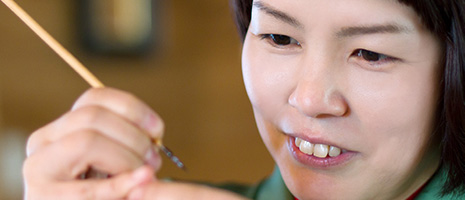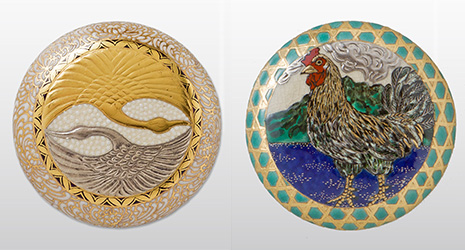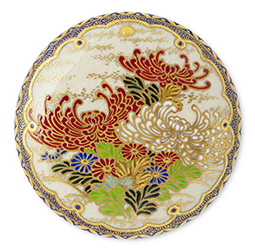Home > Highlighting JAPAN > Highlighting Japan October 2016 > Innovative Artists
Highlighting JAPAN


A Button Reborn
Kagoshima’s traditional craft object the Satsuma button has been given a new lease of life by designer Shiho Murota.
Satsuma-yaki is a style of earthenware named after its place of origin, Kagoshima Prefecture (formerly Satsuma). One of the products traditionally made from this ceramic is the Satsuma button, an ornamental button typically adorned with intricate pictures of the natural world painted in vibrant colors. Captivating foreigners newly arrived in Japan in the mid-nineteenth century in the same way that ukiyo-e woodblock prints did, Satsuma buttons were extensively exported. However, the craft practically died out over half a century ago and today there are only a handful of craftspeople still making the buttons.
Shiho Murota is a ceramic painter from Kagoshima who has worked to revive the art of Satsuma button-making almost since she first laid eyes on a set of genuine Satsuma buttons when she was 28.
“The buttons dated from the beginning of the nineteenth century,” Murota explains. “They were as small as 4 to 5 centimeters across and depicted timeless scenes from Japanese nature. I was immediately inspired by them.”
Murota was a painter of tea pottery at a Satsuma-yaki kiln at the time. In 2005, she chose to become independent and opened her own studio, called Etsuke-sha Satsuma-shishi, in a mountain village in Tarumizu, Kagoshima Prefecture. Her decision has awakened the beauty of the forgotten art of Satsuma buttons.
Initially Murota found it challenging to paint detailed images on a tiny button. It was also difficult, she says, to find a local craftsman capable of making button-shaped Satsuma-yaki earthenware. Murota nevertheless persevered with her art, not with a view merely to reproducing the styles of old, but to creating chic fashion accessories with contemporary appeal.
Murota’s first exhibition in 2007 attracted the attention of art enthusiasts, and since that early success she has held many exhibitions around Japan.
Murota’s Satsuma buttons feature incredibly fine art work hand-painted on buttons as small as 1 to 3 centimeters in diameter. Her motifs include insects, animals and scenes of nature that surround her studio, including the Oniyanma, Japan’s largest dragonfly.
“When I was a child I played in the mountains and grew fond of the insects and animals,” says Murota. “The Oniyanma flying around my studio today are extremely beautiful. The insect’s eyes turn black when it dies, but they are a stunning emerald green while it is alive.”
Murota usually paints on a porcelain button called the “Shiro Satsuma,” which features an ivory-like white glaze with tiny cracks on the surface. The techniques she uses were introduced from Kiyomizu in Kyoto by the craftsmen of Satsuma in the eighteenth century.
First, an outline is drawn in gold or platinum on the button and then the colors are painted in. Next, the button is fired for about four hours in a kiln at 750°C and then cooled outside. The design is then fine tuned with the addition of more color paintwork before the button is fired once more. Further painting is undertaken with gold or platinum, which is followed by another firing at 620°C lasting three hours. Lastly, the gold paint on the surface is polished to complete the production process.
Murota’s Satsuma buttons are available for sale at art shops in Kagoshima, with some buttons being made to order for individual customers. Many purchase the buttons for use as earrings, finger rings and sash clips, Murota says, not just as buttons for clothes.
“Many of my customers buy the buttons as gifts for their close friends or loved ones,” says Murota. “One day I received an order for cufflinks as a present for the customer’s grandfather in celebration of his 70th birthday. I painted them with little birds in violet, which in Japan is considered a symbolic color for seventy years of age.”
Last year Murota participated in the annual convention of the National Button Society in the United States. Her works of art attract a great deal of attention from keen button collectors all around the world. Satsuma buttons have been reborn, captivating overseas art lovers the same way they did 150 years ago.
© 2009 Cabinet Office, Government of Japan







